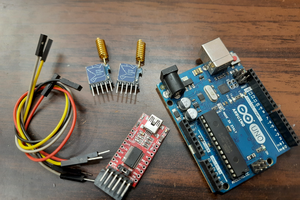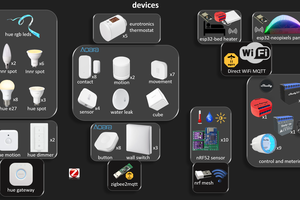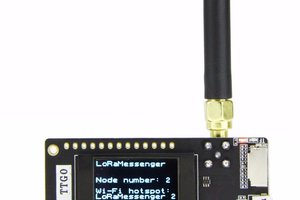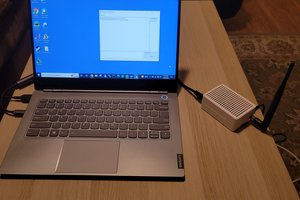Jebel is released under GNU GPL V3 license.
Jebel: Off Grid Communications
Jebel is a LoRa based text communication system for humanitarian and disaster relief situations.
Jebel is a LoRa based text communication system for humanitarian and disaster relief situations.
To make the experience fit your profile, pick a username and tell us what interests you.
We found and based on your interests.
Jebel is released under GNU GPL V3 license.
My first prototype messenger device is finished. It actually feels quite nice in the hand. I think the touch screen is about the right size, though I would love to find a capacitve touch instead of a resistive touch.
The case is a "waterproof" tackle box. I did throw it in a tub of water. It floats and keeps out water, but I wouldn't rate it for submersion. The inserts that hold everything in the box are 3d printed in PETG. The display is a 3.5" Nextion display with 320x480 resolution. The microcontroller running the show is an ESP32 right now I am using a TTGO T-beam which has an ESP32, SX1276 Lora module, NEO m6 GPS module and battery management all on one board. I have also added a buzzer rgb led slider on/off switch, charging port, and a 2000mah lipo.
While all the hardware is working assembly is too fiddly at the moment. I am still deciding which direction to go for the next revision. I will probably roll my own board, specifically because I want to utilize the new more efficient Lora chips. I have some modules using the sx1262 chips that I am looking forward to trying out.
I really love the way the antenna pops out on this unit, but I need to find some better antenna, because these ones are monopoles that really need a ground plane, and the vswr goes through the roof when they are in the case. I rebuilt one turning it into a coiled diplole which works better, but I need to find a reliable supplier for them.
All in all I am happy with the unit as a prototype, but it needs a lot of rework before it would be ready for even a small production run.
On the software side everything works, but needs a lot of tidying up. I have also not done anything yet to optimize battery life.
This is a prototype unit for the repeater system I would like to implement. It is powered by a 6 watt solar panel charging 4 18650 lithium ion cells through a tp4056 controller. The microcontroller is a Lora32u4 which combines an Atmel 32u4 controller with a Semtech sx1276 Lora module. The body is a combination of a waterproof box with some 3d printed PETG elements and folded stainless steel flat stock. The antenna is a 1/4 wave ground plane monopole.
Jebel uses its own protocol specifically designed to be very lightweight and to maximize range and network reliability. It utilizes a hybrid network that employs nodes and repeaters.
There are different ways to create a network of connected devices for a project like this. All of these methods have advantages and disadvantages.
The simplest method which is used is used in traditional walkie talkies is a peer to peer network. In this typology all nodes communicate directly with each other without any intermediary. The messages can be addressed to specific nodes, or to all nodes.
Advantage:
Simple to set up
only requires 2 nodes
flexibility in locations
Disadvantage:
limited to the range of the device.
Another typology is a star configuration where all units send and receive data via a central node. This is the system utilized in Lorawan where all nodes report to a central gateway. In this system nodes do not communicate to each-other directly, but only via the central node.
Advantages:
Centralized network control
allows for monitoring
Disadvantage:
both devices need to be in range of central node
bottleneck at gateway
Another typology is a mesh or repeater mesh typology where every node also acts as a repeater. This has the advantage of giving the highest chance of a message going through as in theory as long as there is a chain of nodes between two nodes they will be able to communicate. This could be a very effective system in a network with only a few nodes, however it quickly becomes problematic with something like Lora which takes a long time to send messages, because when multiple nodes start repeating a message it can create interference, so that all the messages become corrupted.
Advantages:
Doesn’t need established network
Flexibility
any node can communicate with another node
Disadvantage:
can’t deal with numerous nodes
nodes will interfere with other nodes
Jebel utilizes a hybrid system that takes advantage of the benefits of the different systems, but limits the disadvantages of each of these systems. This is being called a Hybrid Repeater Network. In this system each node has a unique address. All nodes have the ability to communicate with any node in range like in a peer to peer network. If a node receives a message it will send back a message received confirmation to the sending node. In this form only two nodes are needed for communication, and they can work anywhere they are in range of each other. If the message is not received by the node however after a set amount of time the node will send a command to repeat the message. Nodes designated as repeaters will repeat the message, and later the message received confirmation. These repeater nodes would be stationary nodes placed on hilltops which maximize the line of sight which is critical for Lora messages. This is why the system is called Jebel which is a transliteration of the Arabic word for mountain. By only allowing nodes with the best locations to repeat messages there is much less noise than in a completely mesh network, which maximizes the chance for a message to get through without creating interference.
To understand...
Read more »What is Lora:
Lora is a proprietary system designed by Semtech. According to them:
LoRa is a proprietary spread spectrum modulation scheme that is derivative of Chirp Spread Spectrum modulation (CSS) and which trades data rate for sensitivity within a fixed channel bandwidth. It implements a variable data rate, utilizing orthogonal spreading factors, which allows the system designer to trade data rate for range or power, so as to optimize network performance in a constant bandwidth. LoRa is a PHY layer implementation and is agnostic with to higher-layer implementations. This allows LoRa to coexist and interoperate with existing network architectures.
Basically Lora which stands for Long Range is a radio modulation system designed for long range low bandwidth applications. The standard is owned by Semtech who licenses several other manufacturers to develop Lora based chips. Lora can be thought of like wifi or bluetooth, but designed for long-range and low-bandwidth applications. It operates in the ISM band with different frequencies for different parts of the world. The three main frequencies are 433mhz, 868mhz and 915mhz. Lora is specifically designed to have a high link budget and operate with a low SNR which allows it to operate at great distances. In low quality environments with high interference and noise it can still be possible to transmit more than 1km. With line of site connections have been made using small battery powered devices that exceed 200km.
Lora devices are transceivers meaning they can both send and receive information. They are low powered. A sender only unit may be able to last years on a single set of batteries if deep sleep and infrequent update times are utilized. The units are also low cost. Though more expensive than equivalent Wifi or Bluetooth modules, Lora modules can still be purchased for well under $10 in single quantities.
Lora vs Lorawan:
Lorawan is a standard protocol for a Lora wide area network. It is built on the Lora technology, and requires Lora to function, but the protocol is not itself Lora. Lora technology can use alternative protocols to Lorawan, as long as it fits within the regulatory guidelines of the country.
Key ideas and terms with Lora:
Lora allows for a number of adjustment to be made to the output signal. All of these adjustment will be a trade off between different factors such as range, ability to transmit in noisy environments, battery usage, time on air, data rate, and message integrity.
Spreading Factor:
According to Semtech “The spread spectrum LoRa modulation is performed by representing each bit of payload information by multiple chips of information. The rate at which the spread information is sent is referred to as the symbol rate (Rs), the ratio between the nominal symbol rate and chip rate is the spreading factor and represents the number of symbols sent per bit of information.” The important take away is a lower spreading factor will mean a higher data rate, but generally lower range as it becomes more difficult to differentiate the signal over noise. Spreading factors range from 6-12 and an increase of 1 SF doubles the time on air. So for the same message SF 9 will take 4 times as long to send as SF7. Generally a lower SF is better as long as the signal is strong enough.
Bandwidth:
“An increase in signal bandwidth permits the use of a higher effective data rate, thus reducing transmission time at the expense of reduced sensitivity improvement.” Bandwidth is measured in kHz. It is the range of the spectrum the signal will broadcast in. According to Semtech the range of possible bandwidths is 7.8-500kHz. The larger the bandwidth the higher the data rate, but also the more noise.
Frequency:
Frequency is the channel in kHz at the center of the transmission. For example 433kHz, 868kHz, or 915Khz.
Coding Rate:
“To...
Read more »My motivation for the project is mostly a practical need. I am working with a hospital in a very remote part of Africa which has no functioning communication system. My main goal is to create a a system to communicate from the main referral hospital to the remote clinics so that we can create a dispatch system for the motorcycle ambulances we are building. The area is very mountainous, so the strategy is to build repeaters on top of the mountains to get a wide area of coverage. The goal would be to have fixed communication terminals at the hospital and the clinics, and mobile nodes on the ambulance units which could be tracked via GPS, and sent SMS messages to dispatch them to where they were needed.
Prototype motorcycle ambulance
Create an account to leave a comment. Already have an account? Log In.
Sorry, I now saw the pole mounted version, more congrats. But you have more than enough battery for 1w, and very secure mounting for a 1/2 wave j-pole, lots more antenna. Good luck.
I understand the drive for that super compact proof-f-concept iteration, congratulations! Have you tested? Certainly seems that 1w would be far more functional, requiring few nodes. Strongly suggest a SO-239 or N-type connector for an external antenna.
Hello. I'm looking for a LORA based communication system, and I find your project, which is relatively close to the system that I was searching for. So I'd like to replicate your project and manufacture 50 nodes and 10 repeater devices with solar power. I need this for an experimental surveillance project for cows and horses that are free to feed themselves on an area around 3 kilometers square into Israels Golan Heights. If the project is successful, it can be that more farmers will be interested in a surveillance system like this. I'm an electronic engineer familiar with electronic devices design and manufacturing. So I shall not have any problems with the manufacturing of these devices. More problematic is for me the software section. I'm familiar with Arduino programming, but this seems to be a more complicated software design. So my question is if you can help me with the software section of a project like this? You can write to my email address czsorin@yahoo.com
Thank you very much
Sorin Czeizler
This looks like a very interesting project that has motivation to get to the final result. I think for the repeater you should be using a 1w lora chip not 100mw which is what comes with the esp. Also you explain that their is no electricity but no solution is give (except a solar panel on the repeater) but what about the nodes? Also the speed is not discussed which is also a relevant factor.
Become a member to follow this project and never miss any updates

 Sagar 001
Sagar 001
 Wassim
Wassim

Hello,
Nice project ;-)
I see you are using lora32u4 II as repeater.
Is that device yet running?
I'm looking for that, is there a .ino code available?
Many thanks,
PhilLu